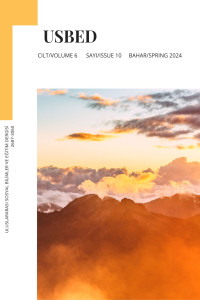Abstract
Modernisme karşı bir tepki hareketi olan postmodernism, tek bir doğrunun olmadığı, alternatif bakış açıları benimseyen bir kavram olarak karşımıza çıkar. Postmodern romanı da öncül gerçekliğe ve doğrulara saldırır ve anlatılanların gerçekliğinin insan tarafından kurgulandığını ve sınırsız sayıda alternatif gerçeklikler kurulabileceğini gösterir. Artık metinlerde satır aralarına gizlenen kapalı uçlu anlatım geleneği kırılır ve bu da edebiyat metinlerinde sayısız dil kullanımlarının önünü açar. Çeşitli dil oyunları ve metinlerarasılık, ironi, pastiş gibi tekniklerle okur birbirinden bağımsız ,uçsuz bucaksız anlam üreten olaylar zincirine dahil edilir. İç içe geçen geri dönüşlerle ve paralel anlatılan hikayelerle okur hikaye boyunca bir girdabın içine sürüklenir. Bu bağlamdaJules Verne’nin Doktor Ox’un Deneyi adlı eseri geleneksel edebi metinleri sorgulamada ve yeniden tanımlamada önemli bir çalışmadır. Kitapta Verne’nin Quiendone halkının stereotiplerini ironik bir şekilde tasvir etmesi, kasabada gerçekleşen olayların inandırıcılığını arttırmak için kurgusal unsurları dahil etmesi ve metinler arası bağlantılar kurması, hepsi postmodernizmle sıkça ilişkilendirilen özellikleri sergilemektedir. Bu çalışmanın amacı postmodernismin öğelerini kullanarak Jules Verne’nin Doktor Ox’un Deneyi adlı eserini postmodern bir incelemeye tabi tutmaktır.
Keywords
References
- Allen, G. (2000). Intertextuality. Routledge.
- Ankersmit, F. R. (1994). History and tropology. University of California Press.
- Anderson, P. (1998). The origins of postmodernity. Verso.
- Barthes, R. (1968). Writing degree zero. Beacon Press.
- Booth, C. Wayne (1975). A rhetoric of irony. University of Chicago Press.
- Best, S., K, Douglas. (1997). The postmodern turn. The Guilford Press.
- Butler. C. (2002). Post-modernism. Oxford University Press.
- Colebrook, C. (2005). Irony. Routledge.
- Connor, S. (1997). Postmodernist culture: An introduction to theories of the contemporary. Blackwell
- Deeds, E. E. (1992). Sequel to history. Princeton University Press
- Fletcher, M. (2017). Reading revelation as pastiche. Bloomsbury
- Harvey, D. (1990). The condition of postmodernity. Blackwell Publishers.
- Jameson. F. (1997). Postmodernism, or the cultural logic of late capitalism. Duke University Press.
- Hutcheon, L. (1995). A poetics of postmodernism. Routledge
- Iggers, G. G. (2009). A search for a postmodern theory of history. [Review of meaning and representation in history, by J. Rusen]. History and Theory, 48(1). Retrieved from www.jstor.org/stable/25478820
- Lodge, D. (1987). The modes of modern writing: Metonymy and the typology of modern literature. Routledge and Kegan Paul.
- Nicol, B. (2009). The Cambridge introduction to postmodern fiction. Cambridge University Press.
- Rosenau, P. M. (1992). Post-modernism and the social sciences. Princeton University.
- Sim, S. (1999). The Routledge companion to postmodernism. Routledge.
- Verne, J. (1875). Dr. Ox’s Experiment and other stories. James R. Osgood and Company.
Abstract
As a countermovement to modernism, postmodernism embraces multiple perspectives and presents a theory in which there is no singular truth. The postmodern novel also challenges the fundamental concepts of reality and truth, demonstrating how the human construction of reality allows for the creation of an unlimited number of alternate realities. The tradition of closed-ended narration buried between lines in texts has been broken, paving the space for numerous linguistic uses in literary writings. The reader is entangled in a sequence of events that generate profound meaning through the use of a variety of linguistic tricks and strategies, including intertextuality, irony, and pastiche. The reader gets sucked into a vortex throughout the novel with intertwining flashbacks and parallel stories. Within this framework, Doctor Ox’s Experiment by Jules Verne is an important work that challenges and redefines conventional literary texts. In the book, Verne's use of irony in portraying the stereotypes of the people of Quiendone, his incorporation of fictional elements to enhance the plausibility of the events in that town, and his establishment of intertextual connections, all demonstrate characteristics commonly associated with postmodernism. The objective of this study is to analyze Jules Verne's literary piece titled Doctor Ox's Experiment via a postmodern lens, employing the key components of postmodernism.
Keywords
References
- Allen, G. (2000). Intertextuality. Routledge.
- Ankersmit, F. R. (1994). History and tropology. University of California Press.
- Anderson, P. (1998). The origins of postmodernity. Verso.
- Barthes, R. (1968). Writing degree zero. Beacon Press.
- Booth, C. Wayne (1975). A rhetoric of irony. University of Chicago Press.
- Best, S., K, Douglas. (1997). The postmodern turn. The Guilford Press.
- Butler. C. (2002). Post-modernism. Oxford University Press.
- Colebrook, C. (2005). Irony. Routledge.
- Connor, S. (1997). Postmodernist culture: An introduction to theories of the contemporary. Blackwell
- Deeds, E. E. (1992). Sequel to history. Princeton University Press
- Fletcher, M. (2017). Reading revelation as pastiche. Bloomsbury
- Harvey, D. (1990). The condition of postmodernity. Blackwell Publishers.
- Jameson. F. (1997). Postmodernism, or the cultural logic of late capitalism. Duke University Press.
- Hutcheon, L. (1995). A poetics of postmodernism. Routledge
- Iggers, G. G. (2009). A search for a postmodern theory of history. [Review of meaning and representation in history, by J. Rusen]. History and Theory, 48(1). Retrieved from www.jstor.org/stable/25478820
- Lodge, D. (1987). The modes of modern writing: Metonymy and the typology of modern literature. Routledge and Kegan Paul.
- Nicol, B. (2009). The Cambridge introduction to postmodern fiction. Cambridge University Press.
- Rosenau, P. M. (1992). Post-modernism and the social sciences. Princeton University.
- Sim, S. (1999). The Routledge companion to postmodernism. Routledge.
- Verne, J. (1875). Dr. Ox’s Experiment and other stories. James R. Osgood and Company.
Details
| Primary Language | English |
|---|---|
| Subjects | Literary Theory |
| Journal Section | Research Articles |
| Authors | |
| Publication Date | April 1, 2024 |
| Submission Date | February 1, 2024 |
| Acceptance Date | March 3, 2024 |
| Published in Issue | Year 2024 Volume: 6 Issue: 10 |
Editor in Chief: Prof. Dr. Aytekin DEMİRCİOĞLU


